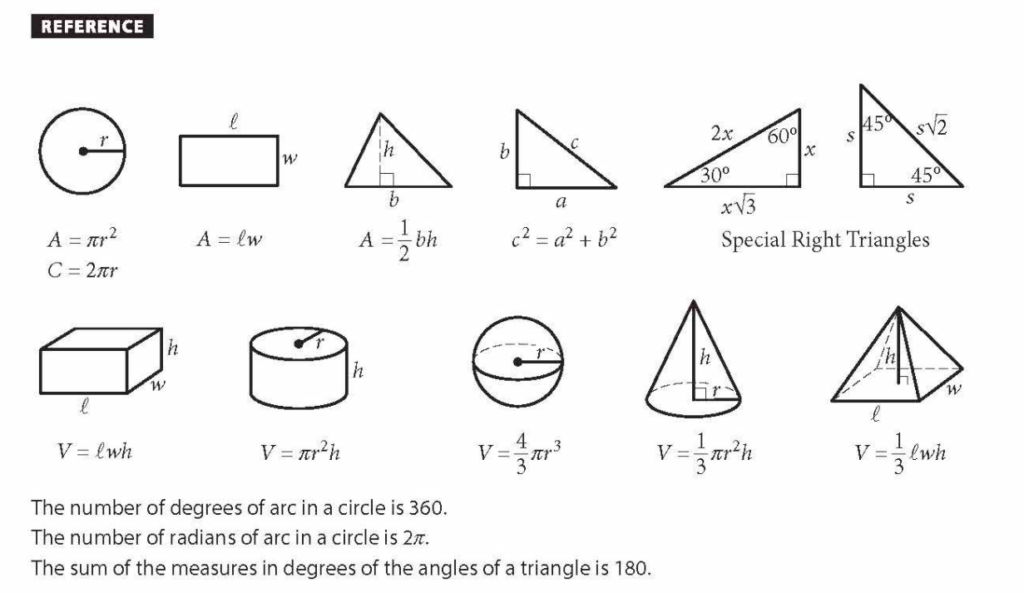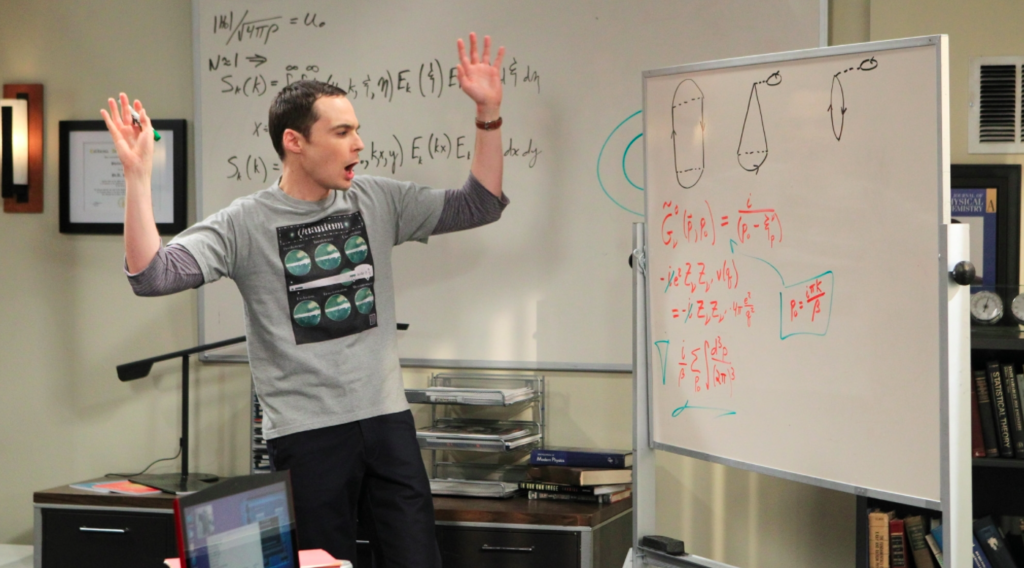The SAT Reference Sheet is a list of common math formulas provided for the math portion of the SAT. This is good news because it means you don’t need to memorize any of these formulas ahead of time. However, it is still important that you’ve seen these formulas before, and that you know how to use them when they come up in questions.
Kickstart Your SAT Prep with Test Geek’s Free SAT Study Guide.
Like any other first introduction, this can be awkward, but we’re here to help break the ice. In this post, we’re going to cover what formulas are on the SAT Reference Sheet and how they can be used to solve problems on the test. There are a few other formulas that you should memorize, but don’t panic, we’ll cover those in this article as well.

About SAT Math
The math section of the SAT makes up half of your total SAT score. Math is split into two sections. One section allows you to use a calculator, but another section prohibits calculator use. You’ll have a raw score from each section, and these two raw scores will be combined and converted into a number on a scale between 200 and 800.
There are 58 math questions in total – 38 on the calculator-optional section, and 20 on the no-calculator section. Most of these questions are multiple-choice; however, there will be 13 “grid-in” questions. On grid-in questions, you’ll be asked to provide your own numeric answer rather than selecting from a list of possible choices.
Questions come from one of these four categories:
- Heart of Algebra – This section focuses on linear equations and systems.
- Problem-Solving and Data Analysis – These questions test your ability to interpret charts, tables, ratios, and statistics. In other words, this section is measuring your quantitative literacy.
- Passport to Advanced Math – This section deals with algebra without exponents, non-linear graphs and functions, and the manipulation of complex equations.
- Additional Topics in Math – This section covers geometry, trigonometry, and complex numbers.
Most of the formulas on the SAT reference sheet have to do with geometry, so they may be most helpful on the “Additional Topics in Math” section. However, there may be times when it’s helpful to use the reference sheet on other types of questions as well.

What formulas are on the SAT reference sheet?
There are eight formulas and five rules or laws on the SAT reference sheet. We’ll cover each one in detail below.
Area of a Circle
What’s the formula? A=πr2
What do the variables represent? A represents the area of a circle. r represents the radius of a circle, or the distance of a straight line between the center and the edge of a circle.
How can I use it? You can use this formula to solve for the area of a circle if given the radius or diameter (divide the diameter by two to find the radius), or to determine the radius of a circle when given the area. For example, let’s say you know the radius of a circle is three centimeters. To solve for area, you can plug it into the formula A=π(3)2. When solved, you will discover that the area is 28.27 cm2.
*NOTE: We won’t say this for each formula or example in this post, but you should know that the SAT often leaves π in its answer choices. So, the answer here could be 9π cm2 rather than 28.27 cm2.
Circumference of a Circle
What’s the formula? C=2πr
What do the variables represent? C represents the circumference of a circle. r represents the radius of a circle, or the distance of a straight line between the center and the edge of a circle. This equation can also be written as C=πd, where d represents the diameter of the circle.
How can I use it? If the test asks you to determine the radius of a circle with a circumference of 27 centimeters. You can plug 27 into the formula for circumference (27=2πr) and solve for r. You’ll come up with an answer of 4.3 centimeters for the radius. Or, say you are asked to determine the circumference of a circle with a radius that is 4 cm long. You can plug 4 into this equation (C=2π(4)) to determine that the circumference is 8π cm.
Area of a Rectangle
What’s the formula? A=lw
What do the variables represent? A is the area of a rectangle. l is the length, and w is the width. If you’re working with a square, the equation can also be written as A=s2, where A represents area and s represents the length of one side.
How can I use it? If you have two out of the three variables available, you can solve for the missing variable. For example, if you know that the area A of a rectangle is 36 cm, and the length l of one side is 9 cm, you can plug these numbers into the equation 36=9w to determine that the width equals 4 cm.
Area of a Triangle
What’s the formula? A=1/2bh
What do the variables represent? A represents the area of a triangle. b represents the length of the base of the triangle, and h represents the height of the triangle from the base up to the highest point.
How can I use it? As with the area of a rectangle, if you’re only missing one variable, it’s easy to plug in the numbers you know to solve for whatever’s missing. If a triangle has a base of 8cm and a height of 6 cm, you can plug the variables into the equation A=1/2(6)(8) to learn that A=24cm.
The Pythagorean Theorem
What’s the formula? a2+b2=c2
What do the variables represent? In a right triangle, c represents the length of the hypotenuse, which is the longest side of the triangle. Then a and b each represent one of the shorter legs of the triangle. It doesn’t matter which leg is a and which is b, as long as the hypotenuse is c.
How can I use it? Suppose you have a right triangle. One side is 4 cm long, and one is six cm long. Using the Pythagorean Theorem, you plug the numbers into the equation (42+62=c2) to determine that c=7.21 cm.

Properties of Special Right Triangles
What’s the formula? This isn’t a special formula. Rather, these are special rules for 30/60/90 or 45/45/90 right triangles.
What do the variables represent? You’ll want to look at the SAT Formulas Sheet for proper context, but in a 30/60/90 triangle, x represents the length of the shortest side. In a 45/45/90 triangle, s represents the length of either one of the shorter legs.
How can I use it? The benefit of these rules is that if you have a 30/60/90 or 45/45/90 triangle, you only need to know the length of one side to solve for the other two. For example, if you have a 30/60/90 triangle, and you know the hypotenuse is 12 millimeters long, you can also determine that the shortest leg is 6 mm, and the longer leg is 10.39 mm.
Volume of a Rectangular Solid
What’s the formula? V=lwh
What do the variables represent? V represents volume, l represents length, w represents width, and h represents height.
How can I use it? For this formula, and for each of the volume formulas on the SAT reference sheet, you’ll take the variables provided and plug them into the equation to solve for the missing variable. For example, if you have a rectangle with a volume of 60 cm3, and you know that the length equals 4cm and the width equals 3cm, you can plug each number into the equation 60=(4)(3)h to determine that h=5.
Volume of a Cylinder
What’s the formula? V=πr2h
What do the variables represent? V represents volume, r represents the radius of the circular side, and h represents the height from the bottom circular side to the top circular side.
How can I use it? Like the formula just above, all you need to do is plug each variable provided into the equation and solve for the missing variable.
Volume of a Sphere
What’s the formula? V=4/3πr3
What do the variables represent? V represents volume and r represents the radius from any point on the surface of the sphere to the middle.
How can I use it? Once again, we have a volume formula that can be used to find – you guessed it – volume. But only if it’s just one variable that you need.
Volume of a Cone
What’s the formula? V=1/3πr2h
What do the variables represent? V represents volume (shocker), r represents the radius of the circular side, and h represents the height from the circular side to the point of the cone.
How can I use it? This formula won’t help you find the volume of a sphere or a pyramid, but if it’s the volume of a cone you need….prepare to be amazed.
Volume of a Pyramid
What’s the formula? V=1/3lwh
What do the variables represent? V represents volume, l represents length, w represents width, and h represents height.
How can I use it? If you need to know the volume of the space where King Tut is buried, or perhaps the volume of the Memphis Bass Pro Shop, this formula will come in handy.

Laws Provided on the SAT Reference Sheet
“The number of degrees of arc in a circle is 360.”
What does this mean? Any time you have multiple sectors in a circle, the angles represented by each sector will always add up to 360.
How is this helpful? Let’s say you have a circle divided into three sectors. The angle of one sector is 136° and the angle of another is 85°. You’re asked to solve for x, which represents the angle of the missing sector. You can simply subtract 136 and 85 from 360 to determine that the third angle is 139°.
“The number of radians of arc in a circle is 2π.”
What does this mean? A radian is an arc with a length equal to the length of the radius of the circle. Every circle has exactly 2π radians.
How is this helpful? I’m going to outsource this one to our friends at the Department of Engineering at Stanford University. They do a great job of breaking this down.
“The sum of the measures in degrees of the angle of a triangle is 180.”
What does this mean? A triangle had three sides. Each side has an angle that can be measured, and these three angles will always add up to 180 degrees.
How is this helpful? If you have a right triangle with a missing angle, but you’re provided with the measure of the other two angles, it’s not hard to find the value of that third angle. You know one angle is 90° and another is 34°. You subtract both numbers from 180 to learn that the final angle is 56°.
What other formulas should I know?
There are a few formulas that aren’t on the SAT reference sheet but are still good ones to know before test day. Here are a few:
Slope of a Line
What’s the formula? y1–y2/X1-x2, where x and y are placeholders for true coordinates of points on a graph.
When would I use it? This formula will be helpful anytime you need to determine the slope of a line on a graph
Slope/Intercept Form
What’s the formula? y=mx+b, where y represents, m represents the slope of the line, x represents, and b is the y-intercept, or the value of y when x=0.
When would I use it? This equation allows you to graph a line by giving you the slope and y-intercept of the line. From there, you can determine the true coordinates of any other points on the graph.
Quadratic Formula
What’s the formula? y=ax2+bx+c, x=-b±√(b2-4ac)/2a
When would I use it? This equation helps you find the roots of a quadratic function or equation. Also, have you ever sung it to the tune of “Pop Goes the Weasel?”

Midpoint Formula
What’s the formula? x1+x2/2, y1+y2/2
When would I use it? This formula is used to determine the midpoint of a line on a graph. You solve for the average of the x values and the average of the y values to get your coordinate.
Distance Formula
What’s the formula? D=√((x1-x2)2+(y1-y2)2), where D represents distance and x and y represent true coordinates.
When would I use it? This formula is used to determine the distance between two points on a line. If you forget this formula on the test, you can also create a right triangle on the graph and calculate the length of the hypotenuse using Pythagorean’s theorem.
Length of an Arc
What’s the formula? (n°/360°)2πr, where n represents the angle of the sector and r represents the radius of the circle.
When would I use it? If you know the radius of the circle and the degree of the angle represented by the sector, you can use this formula to solve for the length of the arc.
Area of Sector
What’s the formula? (Θ°/360°)πr2, where Θ represents the measure of the angle of the sector and r represents the length of the radius of the circle.
When would I use it? If you know the length of the radius and the measure of an angle of a sector, this formula allows you to solve for the area of the sector of the circle.
Sin, Cosine, and Tangent
What’s the formula? You’ve probably heard the acronym SOHCAHTOA before. In a right triangle, the opposite leg is the leg furthest from the given angle, and the adjacent leg is next to the given angle along with the hypotenuse.
- Sine equals Opposite over Hypotenuse (sin(a)=opposite/hypotenuse)
- Cosine equals Adjacent over Hypotenuse (cos(a)=adjacent/hypotenuse)
- Tangent equals Opposite over Hypotenuse (tan(a)=opposite/adjacent)
When would I use it? These are the three basic trigonometric functions. You’ll use these formulas to find the ins and outs of right triangles.
Probability
What’s the formula? The number of favorable outcomes divided by the number of total outcomes.
When would I use it? If you’re asked a question about probability, you’ll probably need to use this formula to solve.
The Pythagorean Theorem
What’s the formula? a2+b2=c2, where c represents the hypotenuse of the triangle, and a and b represent the two shorter legs.
When would I use it? This formula allows you to solve for the length of a missing side of a right triangle, as long as you know the lengths of the other two sides.

How to prepare to use the SAT Reference sheet
At this point, you may be feeling overwhelmed. Don’t worry. You don’t have to memorize EVERYTHING in this article in order to be successful. A better approach is to keep this list handy as you’re going through practice SAT math tests. Take note of which formulas are most useful, and which ones come up most often. Make sure you know those two groups of formulas well.
The practice tests will give you the best idea of what you’re most likely to need on test day. You might also pay attention to what formulas you struggle with the most. Spend extra time on these, so that you don’t have any especially glaring weak spots on the test. If you want to dig even deeper into studying formulas, check out another great TestGeek article here.
One last thing – remember that this doesn’t have to be a solo mission. You CAN get help. Usually, that’s where we come in. Our knowledgeable and experienced math tutors are ready to walk alongside you to help you practice and master these formulas, so you’re ready to put your best foot forward on test day.











Comments